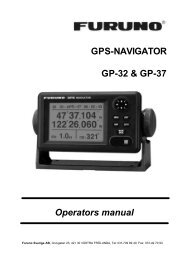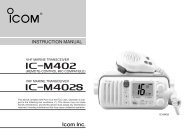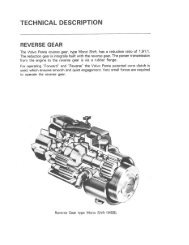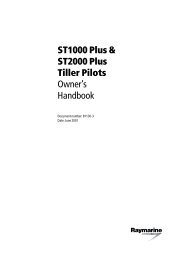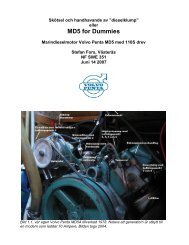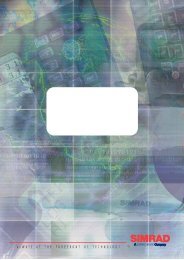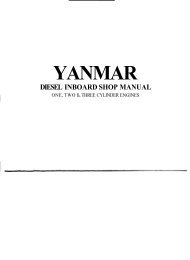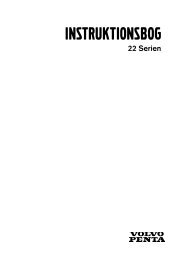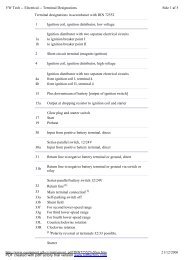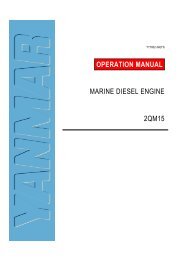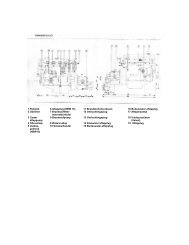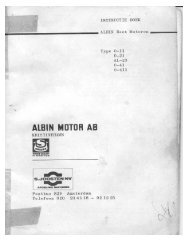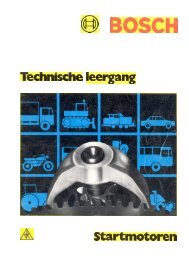Workshop Manual
Workshop Manual
Workshop Manual
- No tags were found...
You also want an ePaper? Increase the reach of your titles
YUMPU automatically turns print PDFs into web optimized ePapers that Google loves.
<strong>Workshop</strong> <strong>Manual</strong>Fuel SystemD2(0)TAMD61A, TAMD62A, TAMD63L-A, TAMD63P-ATAMD71A, TAMD71B, TAMD72A, TAMD72P-A, TAMD72WJ-A
Group 23 Fuel SystemMarine enginesTAMD61A • TAMD62A • TAMD63P-A • TAMD63L-ATAMD71A • TAMD71B • TAMD72A • TAMD72WJ-ATAMD72P-AContentsGeneral instructions .......................................... 2Special tools ....................................................... 9Other special equipment ................................... 9Design and functionGeneral ................................................................ 10Injection pump ................................................ 11Regulator........................................................ 12Pressure variable full load stop ...................... 15Feed pump ..................................................... 15Overflow valve ................................................ 16Fuel injector .................................................... 16Fuel shut-off valve (TAMD 63) ....................... 17Fuel filter ........................................................ 17Repair instructions............................................. 18Injection pump, removal ................................. 18Injection pump, installation and adjustment(TAMD61, -62*), -71, 72*) .............................. 20Injection pump, installation and adjustment(TAMD63**) and TAMD72P-A) ....................... 24Idle speed, adjustment .................................. 27Feed pump, replacement ............................... 28Feed pump, renovation .................................. 29Fuel supply pressure, checking ..................... 30Fuel shut-off valve, trouble shooting............... 31Fuel shut-off valve, renovation ....................... 31Seal in pump drive, replacement(TAMD61, -62, -71) ........................................ 32Seal in pump drive, replacement(TAMD63, -72) ............................................... 33Injector, replacement ...................................... 35Injector, renovation ......................................... 36Copper sleeve, cleaning ................................. 36Recommendations for adjustment of openingpressure, adjustment pressure andreplacement of fuel injectors .......................... 37Opening pressure, adjustment ....................... 38Fuel filter, replacement ................................... 39Fuel system, venting ...................................... 39* Not applicable for TAMD63P-A which is equipped with strokeposition sensor, and TAMD72P-A.** Not applicable for TAMD63P-A which lacks stroke positionsensor.1
General instructionsInformation on SafetyIntroductionThe <strong>Workshop</strong> <strong>Manual</strong> contains technical data, descriptionsand repair instructions for the products orproduct versions from Volvo Penta indicated in thecontents. Make sure that the correct literature isused.Read the following Information on Safety and the<strong>Workshop</strong> <strong>Manual</strong>’s “General Information” and“Repair Instructions” carefully before servicework is begun.ImportantThe following special warning signs are used in the<strong>Workshop</strong> <strong>Manual</strong> and on the products.WARNING! Failure to follow the instructionscan result in personal injury, extensive damageto the product or property, or serious malfunctioning.IMPORTANT! Used to attract attention to whatcan cause injury, malfunction, or damage toproperty.NOTE! Used to attract attention to important informationfor the simplification of work processes or handling.To provide a general understanding of the risks andprecautions to which attention should always begiven we have made the following list.Prevent starting the engine by switching off thepower with the main switch(s) and locking it(them) before service work is begun. Attach awarning label on the instrument panel.All service work should as a rule be conductedwith an idle engine. Some work, e.g. certain adjustments,require the engine to be running. Approachingan engine which is running is a safetyrisk. Remember that loose clothes or longhair can fasten in rotating parts and cause severepersonal injuries.If work is conducted in the vicinity of an enginewhich is running, an unintentional movement ordropped tool can lead to personal injury. Observecare with hot surfaces (exhaust pipe, turbo,air pressure pipe, starter element, etc.) andhot liquids in pipes and hoses on an enginewhich is running or has just been switched off.Refit all guards dismantled during service workbefore starting the engine.Make sure that the warning or information labelson the product are always clearly visible.Replace labels which have been damaged orpainted over.Engines with turbo compressor: Never start theengine unless the air filter is fitted. The rotatingcompressor wheel in the turbo can result in seriouspersonal injuries. Foreign objects in theintake can also result in damage to the engine.Never use start spray or the like to assist starting.This can cause explosion in the intakepipe. Risk of personal injury.Avoid opening the filler cap for coolant (freshwater cooled engines) when the engine is hot.Steam or hot coolant can spray out. Open thefiller cap slowly and release the overpressure inthe cooling system. Observe great care if thetap, plug or coolant pipe must be dismantledwhen the engine is hot. Steam or hot coolantcan flow out unexpectedly.Hot oil can cause burn injuries. Avoid skin contactwith hot oil. Make sure that the oil systemis pressureless before staring work. Never startor run the engine with the oil fill cap removed inview of the risk of oil splash.Stop the engine and close the bottom valve beforeworking on the cooling system.Only start the engine in a well ventilated area.When running the engine in enclosed areas theexhaust fumes and crankcase gases shall beled out of the engine compartment or workshoparea.2
General instructionsAlways use protective goggles when workingwhere this is risk of splinters, sparks, splashingacid or other chemicals. The eyes are extremelysensitive, an injury can result is the loss ofsight!Avoid skin contact with oil! Prolonged or repeatedskin contact with oil can lead to degreasingof the skin, resulting in irritation, drying out,eczema and other skin complaints. From thehealth aspect used oil is more dangerous thannew. Use protective gloves and avoid oildrenched clothes and rags. Wash regularly,especially before meals. Use skin cream forthis purpose to counteract drying out and tosimplify cleaning of the skin.The majority of chemicals intended for theproduct (e.g. engine and transmission oils,glycol, petrol and diesel) or chemicals for workshopuse (e.g. degreasing agents, varnishesand solvents) are hazardous to health. Readthe instructions on the pack carefully! Alwaysfollow prescribed safety instructions (e.g. theuse of breathing protection, protective gogglesand gloves, etc.) Ensure that other personnelare not unintentionally exposed to hazardoussubstances, e.g. via breathing the air. Ensuregood ventilation. Handle consumed and excesschemicals in the prescribed manner.Observe great care when looking for leaks inthe fuel system and testing fuel injectors. Wearprotective goggles. The jet from a fuel injectorhas a very high pressure and high penetrationcapacity; the fuel can penetrate deeply intobody tissue and cause severe injuries. Risk ofblood poisoning.All fuel, in similarity with many chemicals, is inflammable.Make sure that naked flames orsparks cannot cause ignition. Petrol, certainthinners and hydrogen gas from batteries, arein the right proportions with air extremely inflammableand explosive. Smoking prohibited!Ventilate well and take the necessary safetyprecautions before welding or grinding work isbegun in the vicinity. Always have a fire extinguishereasily accessible at the workplace.Make sure that oil and fuel drenched rags, fueland lubricant filters, are stored safely. Oildrenched rags can in certain circumstancesself-ignite. Old fuel and oil filters are environmentallyhazardous waste and should togetherwith consumed lubricant, contaminated fuel,paint residue, solvent, degreasing agent andwashing residue, be handed in to an environmentalstation for destruction.Batteries must never be exposed to nakedflames or electric sparks. Never smoke in thevicinity of batteries. Hydrogen gas developsduring the charging of batteries, which in combinationwith air forms detonating gas. This gasis highly inflammable and very explosive.A spark, which can result from an incorrectlyconnected battery, is sufficient to cause thebattery to explode and cause personal injury.Do not move the connection when starting(spark risk) and do not lean over the batteries.Never confuse the plus and minus terminalswhen fitting the batteries. This can cause seriousdamage to ths can cause serious damageto thwith the wiring diagram.Always use protective goggles during thecharging and handling of batteries. The batteryelectrolyte contains strongly corrosive sulphuricacid. In the event of skin contact wash withsoap and plenty of water. If battery acid hascome in contact with the eyes, rinse immediatelywith water and contact a doctor without delay.Stop the engine and switch of the power withthe main switch(s) before working on the electricalsystem.Adjustment of the clutch should be conductedon an idle engine.3
General instructionsUse the lifting hooks mounted on the engine/reversing gear when lifting the drive unit.Always check that all lifting tackle is in goodcondition and has the correct lifting capacity(weight of engine with reversing gear and extraequipment).For safe handling, and to avoid damaging componentsfitted on the top of the engine, the engineshould be lifted with a lift-bar adjusted tothe engine. All chains or wires should run parallelto each other and as far as possible at rightanglesto the top of the engine.Special lifting tackle may be necessary if otherequipment connected to the engine changes itscentre of gravity, in order to achieve the correctbalance and safe handling.Never work on an engine hanging in liftingtackle.Never work alone when heavy components areto be dismantled, even when secure liftingtackle in the form of lockable pulleys are used.Two persons are normally required even whenlifting tackle is used, one to manage the liftingtackle and another to ensure that all componentsare unobstructed and not damagedduring the lifting.When working on board a boat always makesure in advance that there is sufficient spaceavailable to facilitate dismantling in situ, withoutrisk of personal injury or damage to materials.Components in the electrical system, in the ignitionsystem (petrol engines), and in the fuelsystem on Volvo Penta products are designedand manufactured to minimise the risk of explosionand fire. The engine must not be run in environmentscontaining explosive media.Always use fuel recommended by Volvo Penta.See the Instruction <strong>Manual</strong>. The use of inferiorfuel can damage the engine. On a diesel enginethe use of inferior fuel can lead to jammingof the control rod and over-revving of the engine,with the risk of both damage to the machineand personal injury. Inferior fuel can alsolead to high maintenance costs.4
General instructionsGeneral informationAbout the <strong>Workshop</strong> <strong>Manual</strong>This <strong>Workshop</strong> <strong>Manual</strong> contains technical data,descriptions and repair instructions for the standardversion of engine units TAMD61A, TAMD62A,TAMD63P-A, TAMD63L-A, TAMD71A, TAMD71B,TAMD72A, TAMD72WJ-A, and TAMD72P-A. The<strong>Workshop</strong> <strong>Manual</strong> shows the work procedure conductedon an optional engine as per the above specification,and therefore the illustrations and photographsof certain details may not fully correspondwith other engines. The repair methods, however, remainthe same in all their critical parts. If this shouldnot be the case important differences will be reportedseparately. The engine designation and number isindicated on the rating plate (see <strong>Workshop</strong> <strong>Manual</strong>Group 21 Engine page 15). The engine designationand number should be stated on all correspondenceconcerning an engine.The <strong>Workshop</strong> <strong>Manual</strong> is primarily produced forVolvo Penta service workshops and their qualifiedpersonnel. It is therefore assumed that persons usingthis manual have basic competence on marine drivesystems and can conduct work of a mechanical/electricalnature attendant to this profession.Volvo Penta continuously develops its products, andtherefore we reserve the right to change technicalspecifications without prior notice. All information inthis manual is based on product data available priorto press. Any modifications of critical importance introducedon the product or service methods after thisdate are confirmed in the form of Service Bulletins.Spare partsSpare parts for the electrical and fuel systems aresubject to different national safety regulations, e.g.US Coast Guard Safety Regulations. Volvo PentaGenuine Parts comply with these regulations. Alltypes of damage occurring as a result of the use ofnon genuine Volvo Penta parts for the product inquestion will not be regulated by the warranty undertakingsof Volvo Penta.Certified enginesFor engines which are certified for national and regionalenvironmental legislation the manufacturer undertakesto ensure compliance with environmentalregulations both for new engines and those in use.The product must comply with the approved exampleon certification. In order for Volvo Penta as manufacturerto ensure that engines in use comply with theset environmental regulations the following requirementsfor service and spare parts must be fulfilled:• Service intervals and maintenance proceduresrecommended by Volvo Penta must be followed.• Only Volvo Penta Genuine Parts, intended forthe certified engine version, must be used.• Service which includes the ignition system, ignitionadjustment and fuel injection system (petrol)or injection pumps, pump adjustment and injectors(diesel) shall always be conducted by an authorisedVolvo Penta workshop.• The engine must not be rebuilt or modified in anyway, with the exception of the accessories andservice sets which Volvo Penta has developedfor the engine.• Installation modifications on exhaust pipes andair intake channels for engine chambers(ventilationchannels) must not be made, since this caninfluence exhaust emissions.• Seals must not be broken by unauthorised personnel.IMPORTANT! When spare parts are requireduse only Volvo Penta Genuine Parts.The use of non genuine parts implies thatAB Volvo Penta no longer assumes responsibilityfor the compliance of the enginewith the certified version.All types of damage or costs occurring as aresult of the use of non genuine Volvo Pentaparts for the product in question will not beregulated by Volvo Penta.5
General instructionsRepair instructionsThe work methods described in the <strong>Workshop</strong> <strong>Manual</strong>are applicable for a workshop environment. Theengine is therefore removed from the boat andmounted in an engine block. Renovation work whichdoes not require removal of the engine is conductedin situ with the same work methods, unless otherwisestated.The warning symbols used in the <strong>Workshop</strong> <strong>Manual</strong>(see Information on Safety for implication)NOTE!WARNING!IMPORTANT!These are in no way comprehensive, since we obviouslycannot foresee everything, in that service workis conducted under the most various conditions. Wecan therefore only point out the risks which we considercan arise as a result of incorrect handling duringwork in a well-equipped workshop with workmethods and tools which are proven by us.In the <strong>Workshop</strong> <strong>Manual</strong> all the work procedures forwhich there are special Volvo Penta tools are conductedwith these. The special tools are speciallyproduced to facilitate the most safe and rational workmethod possible. It is therefore the responsibility ofpersons using other tools or another work methodthan that which we recommend to ensure that no riskof personal injury, material damage or malfunctioncan occur.In some cases there may be special safety instructionsand user instructions for the tools and chemicalsnamed in the <strong>Workshop</strong> <strong>Manual</strong>. These instructionsshall always be followed and there are no specialinstructions for this in the <strong>Workshop</strong> <strong>Manual</strong>.By means of taking certain elementary proceduresand using a modicum of common sense, most riskfactors can be prevented. A clean workplace and aclean engine eliminate many risks both of personalinjury and malfunction.Especially during work on the fuel system, lubricationsystem, induction system, turbo, bearing unions andsealing unions, it is of the greatest importance thatdirt or foreign particles do not get in, since this canresult in malfunctioning or shorten the repair servicelife.Our joint responsibilityEach engine consists of a large number of interactivesystems and components. The deviation of a componentfrom the technical specification can dramaticallyincrease the environmental impact from an otherwisefirst-rate engine. It is therefore of extreme importanceto maintain the given wear tolerances, that systemscapable of adjustment receive the correct setting,and that Volvo Penta Genuine Parts are used for theengine. The time intervals in the engine’s maintenanceschedule must be followed.Certain systems, e.g. components in the fuel system,may require special competence and special testequipment. Certain components are sealed at thefactory for environmental reasons. Work on sealedcomponents must not be conducted unless authorisationfor such work is held.Remember that most chemical products, incorrectlyused, are hazardous to the environment. Volvo Pentarecommends the use of biologically decomposing degreasingagents for all cleaning of engine components,unless otherwise stated in the <strong>Workshop</strong> <strong>Manual</strong>.When working on board a boat pay special attentionto make sure that oils and washing residue arehandled correctly for destruction, and do not unintentionallyend up in the nature, e.g. in the bilge-water.Tightening torqueTightening torque for vital unions, which should betightened with dynamometric wrenches, is listed in“Specifications: Tightening torque” and indicated inthe manual’s work descriptions. All torque indicationsare applicable for cleaned threads, screw heads andmating surfaces. The torque indications refer to lightlyoiled or dry threads. If lubricants, locking liquids orsealants are required for the screw union, the type isindicated in the work description and in “Tighteningtorques”. General tightening torque as per the tablebelow is applicable for unions where special torqueindications are not given. The torque indication is astandard value and the union does not require tighteningwith a dynamometric wrench.SizeTightening torqueNmft.IbM5 6 4.4M6 10 7.4M8 25 18.4M10 50 36.9M12 80 59.0M14 140 103.36
General instructionsAngular tightening torqueFor angular tightening torque the screw union is tightenedwith a given torque, thereafter further tighteningwith a predetermined angle. Example: at 90° angulartightening the union is tightened and an additional1/4 turn is made in a work procedure after the giventightening torque has been reached.Lock nutsDismantled lock nuts shall not be reused but replacedwith new items, since the locking propertiesdiminish or are lost with repeated use. For lock nutswith plastic inserts, e.g. Nylock®, the tighteningtorque given in the table shall be reduced if the Nylock®nut has the same nut height as a standard fullmetalhexagonal nut. The tightening torque is reducedby 25% for screw size 8 mm or larger. For Nylock®nuts with higher nut heights, where the fullmetalthread is equally high as a standard hexagonalnut, the tightening torque as per the table are applicable.Strength classesScrews and nuts are divided into different strengthclasses; affiliation is indicated by the marking on thescrew head. A higher number on the marking representsa stronger material, e.g. a screw marked 10–9has a higher strength than a screw marked 8–8. It istherefore important when dismantling screw unionsthat the screws are refitted in their original places.For replacement of screws see the Parts Catalogueto ensure that the correct version is obtained.SealantsA number of different sealants and locking liquids areused on the engine. The properties of the mediumsdiffer, and they are intended for different unionstrengths, temperature ranges, resistance to oils andother chemicals, and for the different materials andcolumn sizes in the engine.In order to conduct satisfactory service work it istherefore important that the correct type of sealantand locking liquids are used for the unions wheresuch are required.In the <strong>Workshop</strong> <strong>Manual</strong> we have indicated in respectivechapters the agents which are used in ourengine production.During service work the same agent, or agent withsimilar properties but of other manufacture, shall beused.When using sealants and locking liquids it is importantthat the surfaces are free from oil, grease, paintand anti-rust agent, and that they are dry.Always follow the instructions of the manufacturerconcerning application temperature, hardening timeand other instructions for the product.Two different basic types of agents are used on theengine, and these are characterised by:RTV-agent (Room temperature vulcanising). Most oftenused with gaskets, e.g. sealing of gasket joints orapplied on gaskets. RTV-agent is fully visible whenthe part has been dismantled: old RTV-agent mustbe removed before the union is sealed again.The following RTV-agents are named in the <strong>Workshop</strong><strong>Manual</strong>: Loctite® 574, Volvo Penta 840879-1,Permatex®.No. 3, Volvo Penta 1161099-5, Permatex® No. 77.Old sealant is removed in each case with denaturedspirit.Anaerobic agents. These agents harden on the absenceof air. The agent is used when two solid parts,e.g. cast components, are fitted together without gasket.A common application is also to secure and sealplugs, threads on pin bolts, taps, oil pressure relays,etc. Hardened anaerobic agents are transparent andtherefore they are coloured to make them visible.Hardened anaerobic agents are very resistant to solventsand old agent cannot be removed. Careful degreasingis conducted prior to refitting, and new sealantis applied.The following anaerobic agents are named in the<strong>Workshop</strong> <strong>Manual</strong>: Loctite® 572 (white), Loctite®241 (blue).NOTE! Loctite® is a registered trade-mark for Loctite Corporation,Permatex® is a registered trade-mark for Permatex Corporation.7
General instructionsSafety instructions forfluorocarbon rubberFluorocarbon rubber is a common material used inseals for shafts and O-rings.When fluorocarbon rubber is exposed to high temperatures(over 300° C) hydrofluoric acid can beformed, which is strongly corrosive. Contact with theskin can result in serious burn injuries. Contact withthe eyes can result in malignant ulcers. Inhalation offumes can injure the respiratory passages.WARNING! Observe great care during work onengines which can have been exposed to hightemperatures, e.g. overheating during seizingor fire. Seals must never be burned loose duringdismantling or subsequently burned in anuncontrolled manner.• Always wear gloves of chloroprene rubber(gloves for handling chemicals) and protectivegoggles.• Handle the removed seal in the same way ascorrosive acid. All residue, including ash, can bestrongly corrosive. Never use compressed air toblow clean.• Place the residue in a sealed plastic tin providedwith a label. Gloves are washes under runningwater before taking them off.The following seals are in all probability manufacturedof fluorocarbon rubber:Seals for crankshafts, camshafts, intermediateshafts.O-rings irrespective of where they are fitted. O-ringsfor cylinder lining sealing are almost always of fluorocarbonrubber.Note that seals which have not been exposed tohigh temperatures can be handled as normal.8
Special toolsIn all cases where it has been practically possible the tools have been stamped with a tool number, excludingthe last digit. The last digit (after the hyphen) is a control number.99960659996066999664099966439996670999677899967799996848 9998011 99980129996065-0 Pressure gauge for checking of chargingpressure.9996066-8 Nipple for checking of supply pressure.9996640-0 Mandrel, used together with extractor99968011.9996643-4 Extractor for injectors.9996670-7 Filter key for fuel filter.9996778-8 Tool for pressing in seal for pump drive,TAMD61, -62, -71.9996779-6 Extractor for seal in pump drive,TAMD61, -62, -71.9996848-9 Adjusting tool for injection pump.9998011-2 Extractor for seal in pump drive,TAMD63, -72.9998012-0 Mandrel for positioning of seal in pumpdrive, TAMD63, -72.Other special equipment9812546-1 Tap brush for cleaning of injector’scopper sleeve.9987057-8 Adjusting tool for fuel pump’s injectionangle.9989876-9 Dial gauge 0.8 in.9812546998705799898769
Design and functionGeneralThe main parts of the fuel system are the fuel tankwith fitting, feed pump, two fuel filters, injection pump,fuel injectors and pipelines.The fuel is induced by the feed pump from the fueltank and pressed through the fine filter to the injectionpump. Excess fuel returns through the overflowvalve (placed on the injection pump) back to the tank.This implies that return fuel flushes through (cools)the injection pump’s fuel chamber. The temperatureof the fuel is thus equalised (and becomes the samefor all the engine cylinders) while gas bubbles in thefuel are avoided.The injection pump then presses at high pressure afuel volume corresponding to the power requirementthrough the delivery pipe to the injectors, which atomisesthe fuel in the engine’s combustion chambers.Return fuel from the fuel injectors is led through theleak-off pipe via the overflow valve and return pipeback to the tank.Note: Certain of the illustrations in this chapter have been kindly putat our disposal by Robert Bosch AB.Fuel system1 Fuel fine filter2 Venting screw3 Delivery pipe from intake pipe (charging pressure)4 Injection pump5 Delivery pipe6 Fuel injector7 Leak-off pipe8 Pressure equaliser9 Centrifugal regulator10 Overflow valve11 Return pipe, lubricant12 Return pipe to fuel tank13 Fuel pipe, intake14 Feed pump15 Hand pump16 Lubricant pipe, intake17 Smoke limiter10
Design and functionInjection pumpThe injection pump is placed on the left-hand side ofthe engine and is driven from the timing gears. Thepump, which is of the piston type, is equipped with6 pump elements (6), one for each engine cylinder,which pump the fuel under high pressure to the engine’scombustion chambers. Each pump elementconsists of piston and cylinder, where the piston ispressed up by the pump’s camshaft (11) by meansof a lifter (10), and pressed back by the pistonspring (9).The piston has a constant stroke length and is actuatedby the regulator, via a control rod (7), whichturns the piston during operation, whereby the injectedfuel volume can be modified.The injection pump is lubricated by means of the engine’slubricating system.The pump element’s pump functionA. When the piston is in its lower position the pressurechamber over the piston is filled with fuelfrom the fuel pump.B. When the piston moves up in the cylinder thefuel supply is shut off. The fuel above the pistonis compressed, the pressure increased, and thepressure valve (1) opens.Injection pump1 Delivery valve retainer2 Thrust plate3 Sealing ring4 Delivery valve5 Flange bushing6 Pump element7 Control rod8 Control sleeve9 Piston spring10 Lifter11 CamshaftC. When the piston has reached a certain height inits upward going movement the relief hole (2) isexposed (also designated inlet hole when thepiston is in its lower position). The fuel flowsback via the zero channel (3) and the piston’sspiral shaped channel (4). The pressure abovethe piston reduces and the pressure valve (1) isclosed. The excess fuel is returned back to thefuel tank.A B CThe pump element’s pump and control functionThe pump element’s control functionThe pump element’s control function is controlled bythe regulator, which via the control rod turns thepump piston. Depending on the position of the pistonin the cylinder the length of the injection time and injectionvolume can vary in that the piston’s spiralshaped channel (4) opens the connection with the reliefhole. If the piston is turned so that the verticalchannel (3) (zero channel) on the pump piston comesopposite the relief hole (2) the fuel will flow back duringthe full piston stroke to the pump’s fuel chamberand the engine will stop.11
Design and functionRegulatorThe regulator has the purpose of controlling the fuelvolume to the engine’s combustion chambers bymeans of activating the throttle control.The regulator is available in two versions:• Centrifugal regulator which is mechanical and isused on engine versions TAMD61A, -62A,-63P-A, -63L-A, -71A, -71B, -72A, and -72WJ-A.• Electromagnetic actuator which is electronic andis used on the engine version TAMD72P-A.The mechanical regulator works with speed sensingregulator weights. The speed is controlled over thefull speed range of the engine, from low idle to highidle.The electromagnetic actuator is controlled from anelectronic control unit which collects information froma number of sensors placed on the engine and control.The control unit calculates with the help of thisinformation the injection volume for each load case.The illustrations below show the differences betweena mechanical regulator and an electromagnetic actuator.Two different basic types of centrifugal regulator areused, RSV and RQV. The RQV regulator is availablein two versions, RQV and RQV-L. The electromagneticactuator is designated RE.The main difference between RQV and RQV-K is thatthe RQV-K regulator can both increase and decreasethe fuel volume during equalising at full load, whilethe RQV regulator’s equalising only gives a reductionof the fuel volume.The following list shows which regulator type is usedfor the different engine versions:– TAMD61A, -62A, -63L-A and -71A/B have aregulator of the RSV type.– TAMD 63-P-A has an RQV regulator.– TAMD72A and -72WJ-A have an RQV-Kregulator.– TAMD72P-A (EDC) has an RE regulator.Principle diagram of injection pump with Centrifugalregulator1 Max. fuel volume2 Min. fuel volume3 Full throttle4 IdleA Control rodB The injection pump’s camshaftC LeverD Centrifugal regulatorPrinciple diagram of injection pump with electromagneticactuator1 Max. fuel volume2 Min. fuel volume3 Full throttle4 Idle5 Position sensor for control rod6 Actuator7 Speed sensorA Control unitB Actuator12
Design and functionCentrifugal regulators RSV, RQV and RQV-KCentrifugal regulator, RSV1 Regulator housing2 Starter spring3 Lever4 Regulator cover5 Set screw for stop and idle6 Tensioning arm7 Control arm8 Regulator spring9 Idle damping spring10 Equalising or idle compression spring11 Set screw for full-load stop12 Regulator arm13 Regulator sleeve14 Centrifugal weight15 Swivel arm16 Rocker arm17 Link rod18 Injection pump’s control rodCentrifugal regulator, RQV1 Link rod2 Full-load stop3 Spring disc4 Play equalising spring5 Injection pump’s control rod6 Adjusting nut7 Regulator springs8 Centrifugal weight9 Angle arm10 Compression ring11 Spring control sleeve12 Guide plate13 Selector arm14 Control piston15 Regulator arm16 LeverCentrifugal regulator, RQV-K1 Adjusting screw for full-load volume2 Full-load stop with cam track (A)3 Set screw for curve path’s angle modification4 Link rod (springs when pulled)5 Injection pump’s control rod6 Adjusting nut7 Regulator springs8 Centrifugal weight9 Angle arm10 Regulator sleeve11 Compression ring12 Control arm13 Muff14 Regulator arm15 Control piston16 Guide plate17 Lever18 Rocker arm13
Design and functionDesign differences between RSV and RQV/RQV-KregulatorsThe basic difference in design between the regulatortypes RSV and RSQ is in the regulator part:• The RSV regulator has an exterior regulatorspring (8), the centrifugal force acts via an arm onthe regulator spring.• The RQV and RQV-K regulators have regulatorsprings (7) built into the centrifugal weights.Principle diagram, regulator part RSV regulator*Design differences between RQV and RQV-KregulatorsRQV and RQV-K have the same basic design of theregulator part, with the regulator springs mounted inthe centrifugal weights. The fundamental difference isthe equalising of the fuel volume at full load.The equalising of the fuel volume in RSV and RQVregulators gives a certain reduction of the fuel volumeat full load and increasing speed, while theRQV-K regulator can both increase and decrease thefull-load volume somewhat.Equalising in the RQV-K regulator occurs in that arocker arm (18) located on the upper end of the regulatorarm (14) senses a guide path (A) on the fullloadstop (2).The guide path is adjusted to the engine’s fuel requirement.The link rod (4), which links the regulatorarm and control rod, transfers movement from therocker arm to the injection pump’s control rod (5).A full-load volume is thereby achieved with correspondsto the required torsional moment.Principle diagram, regulator part RQV regulator** The position descriptions in the diagrams are given onrespective regulators on the previous page.Principle diagram, regulator part RQV-K regulator*14
Design and functionPressure variable full-load stopAll engines with the exception of TAMD72P-A* haveas standard a pressure variable full-load stop (smokelimiter) placed on the front edge of the injectionpump. Its purpose is to prevent exhaust fumes duringrapid accelerations from low speed by means of limitingthe control rod’s stroke length (fuel volume) untilthe turbo compressor has received sufficient exhaustfumes to be able to give full air volume. The smokelimiter is connected with the intake pipe via a plastictube.* TAMD72P-A is not fitted with smoke limiter. Thecorresponding function is integrated in the EDC system.Low charging pressure, small full-load volumeFunction: pressure variable full-load stopThe membrane (1) is actuated when there is achange in the pressure ratio in the intake pipe. Themembrane movement is transferred by means of alink system to the angle lever (2), in the lower part ofwhich an adjusting screw (3) for low max. volume isplace.The screw limits the movement of the control rod atlow charging pressure (A). At high charging pressurethe other end of the screw goes against the stopscrew (4) for high max. volume (B).High charging pressure, large full-load volumeFeed pumpIn order for the injection pump to function it has to besupplied with fuel at a certain pressure. This functionis managed by a feed pump which is placed on theinjection pump. The feed pump, which is of the pistontype, is driven via the injection pump’s camshaft.The feed pump is equipped with a hand pump whichcan be used on an idle engine to pump fuel to the filterand injection pump.1Feed pump1 Hand pump15
Design and functionOverflow valveThe overflow valve, which is placed on the injectionpump, should both limit the feed pressure and providecontinuous venting of the fuel system.When the feed pressure is too high the valve opensand fuel passes through the return line back to thetank. The overflow valve peg and spring can be dismantledand replaced if necessary.Overflow valve1 Valve peg2 Spring3 PlugFuel injectorThe fuel injectors are of the KBEL type, and each fuelinjector consists primarily of a nozzle retainer and anozzle.The purpose of the fuel injector is to:• Atomise the fuel to ensure ignition and combustion.• Mix the fuel jets with the air turbulence in thecombustion chamber to give an optimum mixtureof fuel and air.Function of the fuel injectorWhen the fuel pressure has increased to the setvalve (opening pressure) the nozzle needle (10) lifts,which is held pressed against its seat by the compressionspring (5).Fuel is injected into the engine through precisely calibratedholes in the nozzle sleeve. For the number ofnozzle holes and hole diameters refer to the <strong>Workshop</strong><strong>Manual</strong>, Technical Data.The opening pressure of the fuel injector is determinedby the tension of the compression spring,which can be adjusted with adjusting washers (4).Fuel injector1 Hollow screw2 Gaskets3 Nozzle retainer4 Adjusting washers for setting of opening pressure5 Compression spring6 Thrust pin7 Locating pins8 Guide9 Locating pins10 Nozzle needle11 Nozzle nut16
Design and functionFuel shut-off valve(TAMD63, TAMD71B*, TAMD72WJ-A*)The fuel shut-off valve consists of a solenoid valvewhich on activation changes the direction of flow inthe fuel system.The two flow diagrams show the fuel flow for inactivevalve (A) and activated valve (B).During operation the solenoid valve is inactive andthe fuel has a similar direction of flow as in a systemwith a stop solenoid.* as from engine no. 207181084/xxxx.Function of the fuel shut-off valveDuring operation the feed pump (4) induces fuel fromthe tank (3) via the pre-filter (6). From the pump thefuel is then pressed through the fuel filter (5) and thesolenoid valve (2) to the injection pump (1).When the key switch is moved to stop position the solenoidvalve (2) is activated and the valve switchesthe direction of flow of the fuel. The fuel flow from thetank is blocked and the feed pump becomes connectedon the injection pump’s delivery fuel line.The feed pump builds up an underpressure of approx.4.3–5.8 psi in the injection pump, which impliesthat the pump element cannot be filled with fuel (thepump element requires overpressure for filling).The injection pump is thereby emptied of fuel and theengine stops.The non return valve (7) prevents fuel reaching theinjection pump via the return line.Flow diagram for fuel systemwith fuel shut-off valveA Engine running (solenoid valve not activated)B Stop function activated (solenoid valve activated)1 Injection pump2 Solenoid valve3 Tank4 Feed pump5 Fuel filter6 Pre-filter7 Non return valveFuel filterThe fuel system is provided with two fuel filters connectedin parallel with a joint cover.The fuel filters are of the disposal type and the filterinserts consist of a spiral-wound paper filter. The diagramshows the path of the fuel through the filters.As an accessory the fuel system can be fitted with asingle or double (connected in parallel) water separatingpre-filter. The double pre-filter permits changingthe filter during operation.Path of the fuel through the fuel system’s fine filter17
Repair instructionsInstructions for work onthe fuel systemObserve the greatest possible cleanliness whenworking with the fuel system. Before any componentis dismantled, e.g. fuel pipe, the engine should bewashed. Fit protective caps on all connections sothat no dirt can penetrate. Inspection of the differentcomponent parts should always be conducted in aspecial room separated from other engine servicing.Certain work, e.g. checking of fuel injectors, requiresspecial equipment and training. In the event that thisis lacking such work should be transferred to authoriseddiesel workshops.In the event of a suspected loss of engine power factorssuch as bottom cleanness, propeller selection,boat load and load distribution, should be checkedbefore work with adjusting the pump is started.1Clean the injection pump, piping and engine in thevicinity of the pump.2Does not apply to TAMD72P-ARemove the throttle and stop controls.3Remove the fuel delivery pipes and plug theconnections.Note: The pipes are clamped together. Do not loosenthe clamps, but remove the pipes together.NOTE! For environmental reasons certain adjustmentsare sealed. Work which requires breakingsealed components should only be conducted by authoriseddiesel workshops and their specially trainedpersonnel.All engine warranties become invalid if seals havebeen broken by unauthorised personnel. On completionof work the component shall be resealed with theseals for this purpose (BOSCH or VOLVO PENTA),so that the authorisation number (marking tong’snumber) is clearly visible.Injection pump,removalNote: All fuel and oil pipes including connectionsshall be provided with protective plugs when connectionsare taken apart.This work method applies for all engines presented inthis <strong>Workshop</strong> <strong>Manual</strong>.To distinguish between work procedures which areonly applicable for some engines the text, e.g.Only applicable for TAMD72P-A, is used.Only applicable for TAMD63 and TAMD72WARNING! TAMD63 and TAMD72 have pretensionedfuel delivery pipes. The pipes mustnot under any circumstances be bent or rebent.If a pretension pipe becomes bent or deformedthere is a considerable risk that the pipewill break. A damaged pipe must always be replaced.When removing fuel injectors or injectionpumps the complete pipe unit must be removed.Do not loosen the pipe unit’s clamps todismantle the separate pipes, buy removethree-and-three pipes together.4Not applicable for TAMD72P-ARemove the pipe to the smoke limiter.18
Repair instructions511Remove the pressure equaliser from the injectionpump.12Remove the protective plate over the pump coupling.13Only applicable for TAMD72P-ARemove the contact connection to the injectionpump’s actuator.Note: Protect the connection from fouling.6Only applies to TAMD63P-A, -63L-A, -71B*, -72WJ-A*Remove the pipe to the fuel shut-off valve from the injectionpump and feed pump.Remove the pressure equaliser.Remove the pipe to the fuel filter from the feed pump.Release the clamping screw on the pump coupling137Does not apply to TAMD63P-A, -63L-A, -71B*, -72WJ-A*Remove the pipe to the fuel filter from the injectionpump and feed pump.Remove the fuel feed pipe from feed pump.Remove the screws and sleeves between the pumpcoupling and injection pump’s carrier.8Remove the oil delivery pipe and return oil pipe fromthe injection pump.9Remove the leak-off pipe from the fuel injectors.10Remove the leak-off pipe and return fuel pipe fromthe overflow valve.* Applies to engines with fuel shut-off valves14Dismantle the pump’s 4 attachment screws and liftoff the pump.NOTE! Observe care so that the steel ribs are notdamaged!Send the pump to an authorised diesel workshop(Bosch) for inspection if the workshop does not havespecially trained personnel with the necessary testingequipment.19
Repair instructionsInjection pump, installationand adjustment6TAMD61/62*, TAMD71/72** Not applicable for TAMD63P-A which is equipped withstroke position sensor, and TAMD72P-A.Special tools: 9989876, 9996848.1Check that the pump is in good order, and if necessarytested and approved, before it is fitted. Fill approx.0.1 gallons of engine oil through the hole wherethe oil delivery pipe for lubricating of the pump is tobe fitted (RSV regulator).Do not remove the protective plugs before the pipesare connected.Use new copper washers.2Carefully lift the pump in position. Insert and tightenthe pump’s attachment screws. See the <strong>Workshop</strong><strong>Manual</strong> “Technical Data” page 23 for tighteningtorque.Remove the front valve cover. Remove the rubberplug to the flywheel cover’s inspection hole.7Turn the engine round in its normal direction of rotationuntil the valves on the 1st cylinder are closed(compression stroke).83Only applicable for TAMD71/72Fit the pressure equaliser on the injection pump.4Check that the pump coupling is undamaged, wellcleaned, and completely free from oil and impurities.5Fit the pump coupling together with the injectionpump’s carrier and tighten the nuts. See the <strong>Workshop</strong><strong>Manual</strong> “Technical Data” page 23 for tighteningtorque.NOTE! Do not tighten the clamping screw.Turn the flywheel 1/4 of a turn in the opposite directionto the engine’s direction of rotation. Thereafterturn in the engine’s direction of rotation until the flywheel’sdegree setting is opposite the pointer in theflywheel cover. For the degree setting see the <strong>Workshop</strong><strong>Manual</strong> “Technical Data” on pages 16and 17.Make a precise setting and do not turn the flywheel inthe opposite direction of rotation to fine-adjust thesetting.If the flywheel has been turned too far the adjustmentmust be made from the beginning.Note: Make sure that the line from the mark on flywheelover the pointer is at right-angles to the eyeout from the flywheel. An error of several degreescan occur if the markings are looked at from the side.20
Repair instructions912Tighten the pump coupling’s clamping screw, but nomore than that the coupling can turn freely on theshaft.10Place tool 9996848 on the injection pump.13Remove the hex. socket plug and washer so that the1st lifter on the injection pump is visible.Put dial gauge 9989876 on 9996848.1114Turn back the pump coupling with a pair of tongs approx.1/4 of a turn until the lifter is in its bottom position.Note: Make sure that the pump coupling is not damaged.Adjust the tip of the needle so that it is flush with thelifter. Set the dial gauge to zero.21
Repair instructions15Turn round the pump coupling with a pair of tongs inthe direction of rotation of the pump.Check that the zero setting on the dial gauge is retainedwhen the turn is made.16Continue to turn the pump coupling in the direction ofrotation of the pump until the value for the lift fromthe basic circle (stroke position) is reached on thedial gauge. The value “lift from basic circle” (is givenin the <strong>Workshop</strong> <strong>Manual</strong> “Technical Data” on pages16 and 17.19Check the setting by rotating the flywheel against thedirection of rotation of the engine, a 1/4 turn as initem 8.Then turn the flywheel in the direction of rotation ofthe engine until the correct value of lift from the basiccircle is shown on the dial gauge.Read off the degree marking on the flywheel andcheck that it corresponds with the value in the <strong>Workshop</strong><strong>Manual</strong> “Technical Data” on pages 16 and 17.Note: Make sure that the line from the mark on theflywheel over the pointer to the eye is at right-anglesfrom the flywheel. An error of several degrees canoccur if the markings are looked at from the side.17Turn back the pump coupling in the opposite directionto the direction of rotation to the given value forthe lift from basic circle.20Remove the dial gauge and fixture 9996848 andreplace the hex. socket plug with a new copperwasher.18Tighten the pump coupling’s clamping screw to thespecified tightening torque.21Fit the front valve cover, and if necessary replace thegasket. Put on the inspection cover/rubber plug atthe flywheel cover.22Put on the leak-off fuel pipe on the fuel injectors withnew copper washers.22
Repair instructions23 29Fit the protective plate over the pump coupling.30Vent the fuel system.Put on the fuel delivery pipes.NOTE! The fuel delivery pipes must under no circumstancesbe bent or re-bent. A damaged fuel deliverypipe must be replaced.Fuel delivery pipes from TAMD61/62/71 must not beused on TAMD63/72.31Put on the throttle lever and stop lever.32Start the engine and check for leakage.24Only applies to TAMD63P-A, -63L-A, -71B*, -72WJ-A*Put on the pipes to the fuel shut-off valves from theinjection pump and feed pump.Put on the pressure equaliser.Put on the pipe from fuel filter to the feed pump.25Does not apply to TAMD63P-A, -63L-A, -71B*, -72WJ-A*Put on the pipes from the fuel filters on the injectionpump and feed pump.Put the fuel pipe on the feed pump.Note: On TAMD61/62 the pressure equaliser mustalso be fitted on the hollow screw.26Put on the pipe to the smoke limiter.27Put on the leak-off pipe and return fuel pipe on theoverflow valve.28Put on the oil delivery pipe and return pipe.* Applies to engines with fuel shut-off valves23
Repair instructionsInjection pump, installationand adjustment6TAMD63P-A*, TAMD72P-A* Not applicable for TAMD63P-A which does not havestroke position sensor.Special tools: 99870571Check that the pump is in good order, and if necessarytested and approved, before it is fitted. Fill approx.0.1 gallons of engine oil through the hole wherethe oil delivery pipe for lubricating of the pump is tobe fitted.Do not remove the protective plugs before the pipesare connected.Use new copper washers.2Carefully lift the pump in position. Insert and tightenthe pump’s attachment screws. See the <strong>Workshop</strong><strong>Manual</strong> “Technical Data” page 23 for tighteningtorque.Remove the front valve cover. Remove the rubberplug to the flywheel cover’s inspection hole.7Turn the engine round in its normal direction of rotationuntil the valves on the 1st cylinder are closed(compression stroke).83Only applicable for TAMD72P-AFit the pressure equaliser on the injection pump.4Check that the pump coupling is undamaged, wellcleaned, and completely free from oil and impurities.5Fit the pump coupling together with the injectionpump’s carrier and tighten the nuts. See the <strong>Workshop</strong><strong>Manual</strong> “Technical Data” page 23 for tighteningtorque.NOTE! Do not tighten the clamping screw.Turn the flywheel 1/4 of a turn in the opposite directionto the engine’s direction of rotation. Thereafterturn in the engine’s direction of rotation until the flywheel’sdegree setting is opposite the pointer in theflywheel cover. For the degree setting see the <strong>Workshop</strong><strong>Manual</strong> “Technical Data” on pages 16and 17.Make a precise setting and do not turn the flywheel inthe opposite direction of rotation to fine-adjust thesetting.If the flywheel has been turned too far the adjustmentmust be made from the beginning.Note: Make sure that the line from the mark on flywheelover the pointer is at right-angles to the eyeout from the flywheel. An error of several degreescan occur if the markings are looked at from the side.24
Repair instructions912Tighten the pump coupling’s clamping screw, but nomore than tht the coupling can turn freely on theshaft.10Place adjusting tool for the stroke position sensor9987057 in the regulator housing’s plug hole andconnect the tool.Turn the pump coupling until both the lamps on thetool go on, which implies that the stroke position sensoris between the two spring taps on the tool.Note: When both lamps on the tool 9987057 go onand the engine has the 1st cylinder in the compressionstroke, and when the flywheel shows the degreesetting indicated in the <strong>Workshop</strong> <strong>Manual</strong> “TechnicalDate” on pages 16 and 17, then the engine is correctlyadjusted.Remove the plug from the pump’s regulator housing.1113If necessary adjust the pump by means of looseningthe clamping screw.After adjusting the clamping screw is tightened withthe tightening torque indicated in the <strong>Workshop</strong> <strong>Manual</strong>“Technical Data” on page 23.Turn the engine in the direction of rotation until the strokeposition indicator becomes visible in the plughole in the regulator housing.25
Repair instructions21Fit the front valve cover, and if necessary replace thegasket. Put on the inspection cover/rubber plug atthe flywheel cover.Insert the plug in the regulator housing.22Put on the leak-off fuel pipe on the fuel injectors withnew copper washers.2325Only applicable for TAMD72P-APut on the pipes from the fuel filters on the injectionpump and feed pump.Put on the fuel feed pipe on the feed pump.26Not applicable for TAMD72P-APut on the pipe to the smoke limiter.27Only applicable for TAMD72P-APut on the contact connection to the injection pump’sactuator.28Put on the leak-off pipe and return fuel pipe on theoverflow valve.29Fit the protective plate over the pump coupling.Put on the fuel delivery pipes.NOTE! The fuel delivery pipes must under no circumstancesbe bent or re-bent. A damaged fuel deliverypipe must be replaced.Fuel delivery pipes from TAMD61/62/71 must not beused on TAMD63/72.30Put on the oil delivery pipe and return pipe.31Refill with a volume of engine oil corresponding to thevolume which ran out when the plug for the measuringinstrument was removed.32Vent the fuel system.24Only applicable for TAMD63P-APut on the pipes to the fuel shut-off valves from theinjection pump and feed pump.Put on the pressure equaliser.Put on the pipe from fuel filter to the feed pump.33Not applicable for TAMD72P-APut on the throttle lever and stop lever.34Start the engine and check for leakage.26
Repair instructionsIdle speed, adjustmentNot applicable for TAMD72P-A*The engine should have a normal working temperature.Check that the throttle control functions normally, i.e.that the injection pump’s lever goes against the lowidle stop when the throttle control is moved to idle positionand pressed against the max. stop when thecontrol is moved to max. position.Adjust the control if necessary.Check that the air filter is not blocked.After adjusting the idle speed, sealed adjustingscrews which have been broken shall be sealedagain.* For engine settings for TAMD72P-A, see Service <strong>Manual</strong> “Fuelsystem EDC” Page 26.Adjustment of speed, RSV regulator3Adjust the speed if necessary by removing the capnut and screwing the adjusting screw (1) out or in.If hunting occurs the idle damping should be adjustedas follows:4Remove the cap nut (2), release the lock nut, andturn the damping screw carefully clockwise while observingthe speed.5Check that the high idle speed has not changed. If sothe damping screw has been screwed in too far.6Lock the adjustment screw and screw the domed nuton after adjustment.High idleThe stop for the max. speed is sealed. The seal mustonly be broken by an authorised diesel workshop.7Run the engine warm.1 Adjusting screw for low idle speed2 Adjusting screw, idle stabilising3 Stop screw for high idle speed (sealed)4 LeverLow idle1Run the engine warm.8Run the engine unloaded at the maximum speed.Check that the lever goes against the stop screw (3)for the max. speed.9Check the speed with a tachometer. Adjust if necessarythe stop (3) so that the correct speed is obtained.For engine speed, see “Setting data”, ServiceBulletin Group 24-1.2Run the engine at low idle speed and check thespeed. See “Adjustment data” Service Bulletin Group24-1 for speed.10Seal the screw so that the authorisation number(marking tong number) is clearly visible.27
Repair instructionsAdjustment of speed, RQV regulatorFeed pump, replacement1Wash clean round the pump.2Close the fuel cocks and release the fuel pipes fromthe pump.3Dismantle the feed pump from the injection pump.Adjustment of speed, RQV regulator1 Stop screw for low idle speed2 Stop screw for high idle speed (sealed)3 Lever4Clean the feed pump’s mating surface on the injectionpump and put on a new gasket.5Put on and screw tight the feed pump.Low idle1Run the engine at low idle and check that the low idlespeed lies within the tolerances; see “Adjustmentdata” in Service Bulletins Group 24-1.2If necessary adjust the speed with the stop screw forthe low idle speed (1).High idle speed1Run the engine at max. speed a few seconds withoutload.Check that the high idle speed lies within the tolerances;see “Adjustment data” in Service BulletinsGroup 24-1.2If necessary adjust the speed with the stop screw thehigh idle speed (2). If the speed requires adjustingthe adjusting screw must be sealed on completion ofthe adjustment.6If lubricant has run out of the injection pump a correspondingvolume should be refilled.Remove the screw union for the oil delivery pipe andrefill with oil through the hole.7Vent the fuel system.8Start the engine and check for leakage.28
Repair instructionsFeed pump, renovationPump removed4Dismantling1Remove the pull rod. Screw tight the pump in a vicewith protected jaws.2Feed pump1 Pump housing2 Screw union3 Screw union4 O-ring5 Hand pump6 Gasket7 Spring disc8 Compression spring9 Valve10 Spacer ring11 Pump piston12 O-ring13 Screw union14 O-ring15 Pull rodRemove the screw union (13).Remove the pump piston (2), spacer ring (10), valve(9), and compression spring (8) with spring disc (7).Wash all parts in pure diesel oil.Unscrew the hand pump.InspectionCheck the sealing of the piston in the bore, and thecompression spring tension. Investigate other componentsand replace those which are damaged or worn.3Remove the pump’s inlet and outlet screw unions.29
Repair instructionsAssemblyObserve the greatest cleanliness and rinse the partsin pure diesel oil before assembly.5Put the spacer ring (10) in the pump piston (11).Fuel delivery pressure,inspectionSpecial tools: 9996065, 999606616Put the valve (9), spring disc (7) and compressionspring (8) in the pump piston (11).7Place the pump piston in the pump housing.8Fit the screw union (13) with the O-ring (12).9Fit the screw union (3) with the O-ring (4).Connect the Banjo nipple 9996066 to the existing outleton the fuel filter’s outlet side; see arrow on the filteradapter (measure the pressure after the fuel haspassed through the fuel filter).NOTE! Watch out for fuel spill.Connect to manometer 9996065.10Fit the hand pump (5) with the gasket (6).11Put the O-ring (14) on the pull rod (15) and place thepull rod in the screw union (13).Fit protective plugs for the connections if the pump isnot to be fitted on the injection pump immediately.2Run the engine at high speed and then reduce thespeed to low idle and read the pressure within oneminute. The delivery pressure must not be less than15.5 psi. Low delivery pressure can be a result ofblocked filter, defective overflow valve or defectivefeed pump. Check that there is no restriction, e.g.clenched pipe.30
Repair instructionsFuel shut-off valve,trouble shootingTAMD63, TAMD71B*, TAMD72WJ-A*If the engine does not stop when the key switch ismoved to stop position the following items should bechecked:• Check that there is voltage to the solenoidvalve’s connector when the key switch is in stopposition. Violet cable should have voltage onstop.• Connect to the connector and listen for functionnoise. Does the valve click when stop is connected?Check the plunge function if necessary.• Check that the injection pump’s overflow valve istight in the return direction so that fuel cannotreach the injection pump via the return pipe.* As from engine no. 207181084/xxxxFuel shut-off valve,renovationTAMD63, TAMD71B*, TAMD72WJ-A** As from engine no. 207181084/xxxx1Clean the fuel shut-off valve carefully.3Release the terminal (1).4Dismantle the valve from the bracket.5Brace the valve in a vice with protected jaws.6Dismantle the solenoid (2).7Blow clean the valve’s fuel channels with compressedair.8Replace the solenoid’s sealing rings (3). Fit the solenoid.Tightening torque 20 ft. Ib.9Fit the fuel shut-off valve to the bracket.10Fit the fuel hoses.2Close the fuel cocks and release the fuel hoses fromthe nipples. Make sure that dirt cannot get into thefuel hoses; fit protective plugs if necessary.31
Repair instructionsSeal in pump drive,replacementTAMD61, -62, -71Special tools: 9996778, 99967791Remove the front valve cover. Remove the rubberplug to the flywheel cover’s inspection hole.6Remove the guide sleeves and lift off the pumpcoupling. Look after the washers between the steelribs and pump coupling.5Remove the front carrier from the drive outlet’s shaftjournal.2Turn round the engine in its normal direction of rotationsuntil the valves on the 1st cylinder are closed(compression stroke).63Remove the protective plate over the pump coupling.4Screw the extractor 9996779 in the seal.Press on the extractor so that its thread cut into theseal’s steel ring. Remove the seal.Remove the four screws for the pump coupling.Note: Do not remove the screws which hold thecarrier discs on the carrier.7Oil in the new seal and shaft journal. Place the sealon the shaft.85Release the clamping screw which hold the carrier onthe drive shaft.Press in the seal with tool 9996778 until the seal isflush with the housing.32
Repair instructions9Put the front carrier on the drive shaft. Put on thepump coupling together with washers, guide sleevesand screws.Tighten the screws with a torque of 22 ft. Ib.10Adjust the injection pump.See repair instructions on pages 20–23.Seal in pump drive,replacementTAMD63, -72Injection pump removedSpecial tools: 9996640, 9998011, 9998012Note: The distance between the timing gears bearinghousing and the injection pump does not permitspace for the tools needed to replace the seal. Theinjection pump must therefore be dismantled beforethe seal is replaced.For dismantling and fitting of the injection pump seethe repair instructions on pages 18 and 19, and24–26.1Release the clamping screw and remove the carrierfrom the shaft.2Insert mandrel 9996640 in extractor 9998011.Turn the mandrel with the shallow hole towards theextractor screw.33
Repair instructions35Oil in the new seal and shaft.6Screw the extractor in the old seal by means of amandrel.4Place the seal on the shaft and tap it in flush with thehousing with mandrel 9998012.7Put the carrier on the shaft but do not tighten theclamping screw.Pull out the old seal by means of screwing in thescrew on the extractor, while holding the extractorwith the mandrel.34
Repair instructionsFuel injector, replacementSpecial tool: 99966431Clean round the fuel injectors and pipe connections.2Only applicable for 7(x) series.Remove the exhaust temperature sensor from the exhaustcollector pipe.8Clean the surface of the copper sleeves to the fuel injectors.9Insert the new fuel injectors.10Insert new rubber seals round the fuel injectors.3Remove the leak-off pipe between the fuel injectorsand plug the connections.114Remove the fuel delivery pipe and plug the connections.NOTE! The fuel delivery pipes must under no circumstanceby bent or re-bent. A damaged fuel deliverypipe must be replaced.Fuel delivery pipes from TAMD61/62/71 must notused on TAMD63/72.5Remove the nuts for the fuel injectors’ anchorageyoke and remove the yoke.Fit the anchorage yoke and tighten the nuts with atorque of 37±3.7 ft. Ib.6Remove the rubber seals round the fuel injectors.12Fit the leak-off pipe with new copper washers.713Fit the fuel delivery pipes.147(x) series only.Fit the exhaust temperature sensor.Turn the injectors with a PU-15 wrench and pull themupwards at the same time. If the injector has stuckand can not be pulled up by hand, use extractor9996643 There is otherwise a risk of water entry.15Start the engine and check for leakage.35
Repair instructionsFuel injector, renovation1Clean the exterior of the fuel injector.Copper sleeve, cleaningSpecial tool: 981254612Take the injector to pieces. If several injectors arecleaned at the same time, make sure that the injectorneedles and injector nozzles which belong togetherand have been selectively assembled are not mixedup. To avoid mixing, the nozzles should be put in aninjector rack or in different boxes.3Clean the injector.To get an acceptable result when cleaning injectors, itis important that they are cleaned with an ultrasoundcleaner. If the workshop does not have access to itsown ultrasound cleaner, this can be done at the nearestBosch workshop.Before the brush is fitted in a drill, press down themounting sleeve over the brush so that it is held together.24Check the nozzle carefully. Inspection is made withlamp magnifier or microscope. The nozzle sleeve canalso be checked in the microscope. If the seat isworn the nozzle needle must be replaced togetherwith the nozzle sleeve or, if only slightly damaged,ground in a nozzle grinding machine.5Check the other parts.6Dip the nozzle parts in pure diesel or testing oil.Place the mounting sleeve over the copper sleeve.37Press down the brush in the copper sleeve. Connecta drill and clean the copper sleeve.Assemble the nozzle with the same thickness of adjustingwashers for the opening pressure as the originalones.4After cleaning, blow off any impurities with compressedair.36
Repair instructionsRecommendation for adjustmentof opening pressure,adjustment pressure andreplacement of fuel injectorsFuel injection takes place at very high pressure sothat the atomisation of the fuel will be as efficient aspossible. The opening pressure of the fuel injectorsdrops in time below the pressure indicated for newinjectors.This drop in pressure is quite normal and does not affectthe function of the fuel injectors and the engineperformance to any considerable extent.Adjustment of the fuel injectors can reduce the service-lifeof the nozzles.To avoid unnecessary replacement and adjustmentof fuel injectors we provide the following general instructionsas to how the fuel injectors should be inspected.The fuel injectors should not be checked unless thereis a clear indication that they are functioning irregularly,e.g. a strong increase in exhaust fumes.Testing of the opening pressure, adjustment pressure,and tightness, are the most important.Spray pattern and chatter are more difficult to evaluateand do not give a reliable indication of the conditionof the nozzle.In our service literature we indicate in addition to theopening pressure also the adjustment pressure.These values refer to new fuel injectors, or injectorswith new compression springs.In that the adjustment pressure for a new spring issomewhat higher than the opening pressure there isa certain margin for the compression spring to settle.When a new compression spring has settled, the openingpressure falls by about 8-10 bar.The opening pressure will also drop in time, but thefuel injector will continue to function satisfactorily.Surveys have shown that the pressure drop evensout at approx. 15 % below the opening pressure, fora used spring. This pressure drop lies within thespecified working range.Tightness testingDuring tightness testing a check is made to see if anyleakage occurs from the nozzle. If there is leakage itwill be between the tip of the nozzle needle and theconical sealing surface of the nozzle sleeve.Wipe the nozzle tip dry. Pump the pressure up withthe pressure gauge connected, to 2 MPa (20 kp/cm 2 )beneath the opening pressure of the injector. Hold thepressure constant for 10 seconds. No fuel shoulddrip from the nozzle tip, but it is permissible if it becomeswet.Injection pressure and rattleThe condition of the injector is difficult to determine asregards injection pattern and rattle. The performanceof an injector in the engine can frequently be acceptable,although both injection pressure and rattle areopen to question.YA1A2A3A4XY Opening pressureX Operation timeA1 New springA2 Old springA3 8–10 bar differenceA4 The injector still works well despite a 10%fall in opening pressure.37
Repair instructionsOpening pressure, adjustment41Connect the fuel injector to a nozzle tester.2Press the tester lever slowly down until the nozzlereleases fuel.3Read off the opening pressure on the manometer.If the opening pressure reading does not correspondwith the prescribed value the setting can be changedby replacing the adjusting washers in the fuel injector.Note: Max. two washers must be used. If the thickestwashers are not sufficient to obtain sufficient pressurethe spring should be replaced.Opening pressure/adjustment pressureRefer to the <strong>Workshop</strong> <strong>Manual</strong> “Technical Data” onpage 17 for opening pressure and adjustment pressure(new spring).Spray patternAt a pump speed of 4–6 strokes/second the spraypattern should be uniform and the fuel atomised.Seal the pipe connections and nozzle tip with protectivecaps on completion of the test.38
Repair instructionsFuel filter, replacementSpecial tool: 99966701Clean the filter bracket well.Fuel system, venting12Put a collection vessel beneath the fuel filter.Open the vent nipple on the fuel filter retainer.Remove the filter with tool 9996670.3Moisten the new filter gaskets with oil and screwthem on by hand until the gaskets come in contactwith the bracket. Thereafter turn the filter an additionalhalf turn.4Vent the fuel system. Start the engine and check thetightness round the filter.2Fill the fuel system by pumping the feed pump’s handpump. When the fuel which flows out through thevent nipple is free from air bubbles close the ventnipple while the fuel is flowing out. Additional ventingis not normally required.3If the injection pump requires venting release the connectionfor the overflow valve. Continue pumping withthe hand pump until there are no air bubbles in thefuel.Thereafter tighten the connection while the fuel isflowing out.39
Report formDo you have any complaints or other comments about this manual? Please make acopy of this page, write your comments down and post it to us. The address is atthe bottom of the page. We would prefer you to write in English or Swedish.From: ..............................................................................................................................................................................................................................................................................................................................................Refers to publication: .............................................................................................................................................Publication no.: ..................................................................... Issued: ....................................................................Suggestion/reasons: ..............................................................................................................................................................................................................................................................................................................................................................................................................................................................................................................................................................................................................................................................................................................................................................................................................................................................................................................................................................................................................................................................................................................................................................................................................................................................................................................................................................................................................................................................................................................................................................................................Date:............................................................Name: ..........................................................AB Volvo PentaCustomer SupportDept. 42200SE-405 08 GothenburgSweden
7738299-2 English 02-1997




